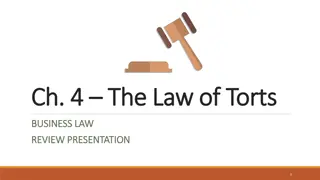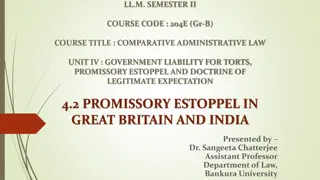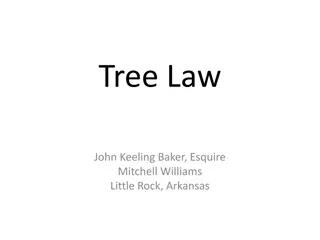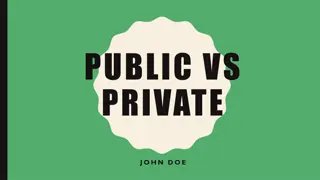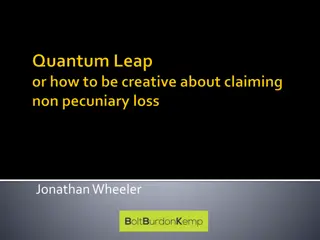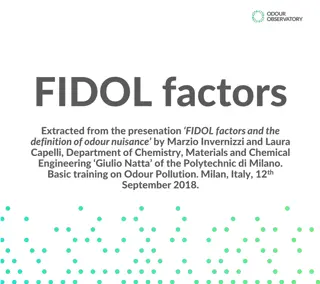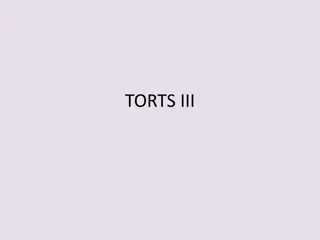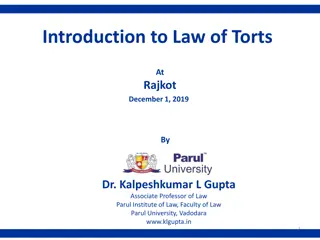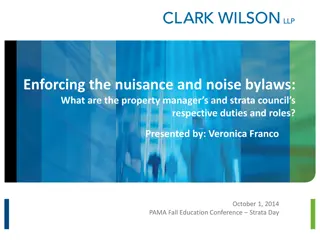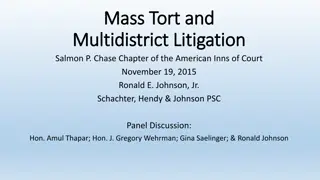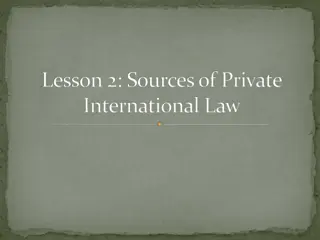Understanding Private Nuisance in Torts Law
Private nuisance involves interference with a person's use and enjoyment of their land, categorized into three types. To prove a private nuisance, one must show harm caused by encroachment, physical injury, or interference with quiet enjoyment. Not all annoyances qualify as private nuisances. Remedies and defenses are available in such cases.
Download Presentation

Please find below an Image/Link to download the presentation.
The content on the website is provided AS IS for your information and personal use only. It may not be sold, licensed, or shared on other websites without obtaining consent from the author. Download presentation by click this link. If you encounter any issues during the download, it is possible that the publisher has removed the file from their server.
E N D
Presentation Transcript
Torts connected to land Private Nuisance
Learning Objectives By the end of the session you should be able to: Define private nuisance and identify the main features 1. Identify the three types of private nuisance 2. Explain the requirement for an interest in the land 3. Explain the requirement for unreasonable use of land 4. State the importance of showing damage, injury or loss of convenience 5. Explain the main defences available 6. Identify the remedies available 7.
What is a Private Nuisance? A private nuisance is an interference with a person's enjoyment and use of his land. It is a civil action.
Nuisance Please note that when the courts and law reports refer to a nuisance , they are usually referring to a private nuisance and not a public nuisance. When statute law refers to a nuisance it usually means both public and private nuisance unless otherwise stated.
Types of Private Nuisance Private nuisances are of three kinds: Nuisance by encroachment on a neighbour's land 1. Nuisance by direct physical injury to a neighbour's land 2. Nuisance by interference with a neighbour's quiet enjoyment of his land. 3. Lord Lloyd in Hunter and Others v Canary Wharf Ltd [1997] and Hunter and Others v London Docklands Corporation [1997] https://www.publications.parliament.uk/pa/ld199697/ldjudgmt/jd970424/hunter01.ht m
Question Can you think of how the damage might be caused with each of the three types of private nuisance?
Types of Private Nuisance Private nuisances are of three kinds: Nuisance by encroachment on a neighbour's land: the roots from a tree in my garden grow under the ground and into my neighbour s garden damaging the foundations of my neighbour s house. 1. Nuisance by direct physical injury to a neighbour's land: I drive my car over my neighbour s garden damaging her garden. 2. Nuisance by interference with a neighbour's quiet enjoyment of his land: I play Justin Bieber music all through the night and every night stopping my neighbour from sleeping. 3.
Not All Annoyances are Actionable Just because something is an annoyance does not mean it is actionable in private nuisance. For example, interference with television signals by a building is an annoyance but is not actionable as a private nuisance.
Interference with Television Signals Facts: In Hunter and Others v Canary Wharf Ltd [1997], the claimants sought damages for private nuisance in respect of interference with the television reception at their homes caused by the construction of Canary Wharf. Held: The House of Lords stated by a majority decision that no action lay in private nuisance for interference with television caused by the mere presence of a building.
Hunter and Others v Canary Wharf Ltd [1997] Lord Lloyd stated: The annoyance caused by the erection of Canary Wharf and the consequential interference with television reception must have been very considerable. But unfortunately the law does not always afford a remedy for every annoyance, however great. https://www.publications.parliament.uk/pa/ld199697/ldjudgm t/jd970424/hunter01.htm
Characteristics of a Private Nuisance A private nuisance has the following key elements: The claimant must have an interest in the land There must be unreasonable use of the land which is the source of the nuisance The claimant must suffer some harm.
An Interest in the Land A claimant must have an interest in the land affected by the nuisance in order to make a claim of private nuisance. In effect, an interest in land means a person must own or have a right over the land. Owners, leaseholders or tenants have an interest in the land and can make a claim of private nuisance. Persons such as visitors, family members and lodgers do not have an interest in the land and cannot make a claim of private nuisance.
A Interest in Land: Exclusive Possession In effect a person who is in exclusive possession of the land is regarded as having an interest in the land. In Foster v Warblington UDC (1906), the claimant was able to bring a claim of private nuisance because he was in exclusive possession of the land even though he could not prove his title to it.
Foster v Warblington UDC (1906) Facts: The claimant was an oyster merchant who for many years had been in occupation of oyster beds artificially constructed on the foreshore. The claimant excluded everybody from the oyster beds, and nobody interfered with his occupation of the oyster beds or his removal and sale of oysters from them. However the claimant could not prove ownership of the oyster beds. Held: The claimant could bring an action in private nuisance caused by the discharge of sewage by the defendants into the oyster beds.
Malone v Laskey [1907] Facts: a company had rented a house for one of their managers to live in. The wife of the manager was injured when a bracket in a lavatory fell on her head caused by the vibrations of machinery on the defendant s property. Held: The Court of Appeal decided that the wife could not make a claim of nuisance because she had no interest in the property.
Khorasandjian v Bush [1993] The daughter of a property owner brought an action to obtain an injunction against a man who was harassing her including making nuisance telephone calls. The county court granted an injunction preventing the defendant from harassing pestering or communicating with the claimant. It was argued by the defence that the injunction could prevent the defendant from assaulting or threatening to assault the claimant because that was covered by the tort of trespass to the person. However, it was argued by the defence that the current wording of the injunction did not reflect any known tort. http://www.bailii.org/ew/cases/EWCA/Civ/1993/18.html
Khorasandjian v Bush [1993] The Court of Appeal held that the wording of the injunction should remain unaltered. As part of their reasoning they argued that the telephone harassment was covered by the tort of private nuisance because it was an actionable interference with her ordinary and reasonable use and enjoyment of property where she is lawfully present. The Court of Appeal was particularly concerned that at that time there was no alternative action the woman could take. The woman would now be able to obtain protection under the Protection from Harassment Act 1997. http://www.bailii.org/ew/cases/EWCA/Civ/1993/18.html
Khorasandjian v Bush [1993] Dillon LJ stated: To my mind, it is ridiculous if in this present age the law is that the making of deliberately harassing and pestering telephone calls to a person is only actionable in the civil courts if the recipient of the calls happens to have the freehold or a leasehold proprietary interest in the premises in which he or she has received the calls. http://www.bailii.org/ew/cases/EWCA/Civ/1993/18.html
Hunter and Others v Canary Wharf Ltd [1997] Hunter and Others v London Docklands Corporation [1997] In both cases the claimants included not only property owners and tenants but members of their families and lodgers. Both cases were heard by the House of Lords at the same time. The facts of Hunter and Others v Canary Wharf Ltd [1997] were outlined earlier. The case of Hunter and Others v London Docklands Corporation [1997] concerned damage caused by dust created during the construction of a road. Both cases included actions for nuisance. The House of Lords had to decide which persons could bring an action in private nuisance. They decided that only householders with a right to land could commence an action in private nuisance. In doing this, the House of Lords rejected the decision in Khorasandjian v Bush [1993] but upheld the decision in Malone v Laskey [1907].
Hunter and Others v Canary Wharf Ltd [1997] Hunter and Others v London Docklands Corporation [1997] Lord Goff commenting on the Court of Appeal s decision in Khorasandjian v Bush [1993]: In truth, what the Court of Appeal appears to have been doing was to exploit the law of private nuisance in order to create by the back door a tort of harassment which was only partially effective in that it was artificially limited to harassment which takes place in her home. I myself do not consider that this is a satisfactory manner in which to develop the law, especially when, as in the case in question, the step so taken was inconsistent with another decision of the Court of Appeal, viz. Malone v. Laskey, by which the court was bound https://www.publications.parliament.uk/pa/ld199697/ldjudgmt/jd97 0424/hunter01.htm
Unreasonable Use of Land The use of the land which is the source of the nuisance must be unreasonable for a claim of private nuisance to succeed. In deciding whether the use of land is unreasonable, the courts will consider factors such as: The sensitivity of the claimant The duration of the nuisance The character of the area The reasonable foreseeability of the type of damage and Any malice on the part of the defendant.
Sensitivity of the Claimant The standard of tolerance is that of the reasonable person and ordinary land use. Abnormally sensitive claimants or using land for an unusual purpose that makes it sensitive to disruption, are unlikely to succeed in a claim for private nuisance.
Robinson v Kilvert (1888) Facts: The defendant let a floor of his property to a tenant to be used as a paper warehouse, retaining the cellar immediately below The tenant brought an action to prevent his landlord from heating the cellar, on the grounds that the rising heat dried his special brown paper making it less valuable. Ordinary paper would not have been damaged. Held: There was no private nuisance. The Court of Appeal argued that: [a] man who carries on an exceptionally delicate trade cannot complain because it is injured by his neighbour doing something lawful on his property, if it is something which would not injure anything but an exceptionally delicate trade. Per Lopes, L.J.
Duration and Time of the Nuisance The duration and time of the alleged nuisance can determine whether a private nuisance has been created. In Halsey v Esso Petroleum Co Ltd [1961] the High Court held that a private nuisance was created by noise at night from boilers and road tankers.
Duration and Time of the Nuisance Generally speaking the courts require a private nuisance to be a continuing state of affairs. However, there are exceptions to this requirement. For example, in Crown River Cruises Ltd v Kimbolton Fireworks Ltd [1996], a firework display that set fire to some moored barges was held to be a private nuisance.
Crown River Cruises Ltd v Kimbolton Fireworks Ltd [1996] C.L.C. 1214 It seems to me that those authorities which have held that a particular type of interference has not amounted to a nuisance by reason of its short duration, have generally been concerned with complaints relating to nuisance, noise, vibration, dust, etc. which are to an extent to be regarded as a normal incident of urban living, in respect of which a degree of give and take is to be expected, unless by undue length or repetition they become intolerable. Where an activity creates a state of affairs which gives rise to risk of escape of physically dangerous or damaging material, such as water, gas or fire, then the law of nuisance is, and should be, available to give a remedy in respect of that state of affairs, albeit brief in duration. Per Potter J.
The Character of the Area The character of the area in which the alleged nuisance occurred is relevant in deciding whether there is a private nuisance.
Activity Use a textbook or multimedia device to find out the facts and decisions in the following two cases: Sturges v Bridgman (1879) Miller v Jackson [1977]
Question Do you think that the decisions in both cases were fair?
Coming to a Nuisance It is no defence in a case of private nuisance to argue that the nuisance was there long before the claimants came to it. It may be that this rule works injustice, it may be that one would decide the matter differently in the absence of authority. But we are bound by the decision in Sturges v Bridgman and it is not for this court as I see it to alter a rule which has stood for so long. Miller v Jackson [1977] per Lane L J.
The Character of the Area [W]hether anything is a nuisance or not is a question to be determined, not merely by an abstract consideration of the thing itself, but in reference to its circumstances; what would be a nuisance in Belgrave Square would not necessarily be so in Bermondsey; and where a locality is devoted to a particular trade or manufacture carried on by the traders or manufacturers in a particular and established manner not constituting a public nuisance, Judges would be justified in finding, and may be trusted to find, that the trade or manufacture so carried on in that locality is not a private or actionable wrong. Sturges v Bridgman (1879) Per Thesiger LJ.
The Character of the Area In St Helen's Smelting Co v Tipping (1865), it was held that although the character of the area is important that did not prevent a successful action in private nuisance for damage to property. In this case damage caused by vapours from a factory was held to be a private nuisance even though there were many other factories in the neighbourhood who also emitted vapours.
Wheeler v Saunders Ltd [1994] Facts: The claimant owned a house which was next door to a farm. He claimed that a private nuisance had been created by the granting of planning permission for the building of two new pig houses where the smell of the pigs and their excrement was interfering with his use and enjoyment of the house. The defendants argued that the granting of planning permission changed the character of the area so that what would have once been a private nuisance was no longer a private nuisance.
Wheeler v Saunders Ltd [1994] The Court of Appeal held that: The granting of planning permission for a pair of pig houses did not alter the character of the area and therefore what was once a private nuisance is still a private nuisance The granting of planning permission does not authorise the creation of a private nuisance The defendants were liable for private nuisance. http://www.bailii.org/ew/cases/EWCA/Civ/1994/32.html
Coventry and others v Lawrence[2014] The Supreme Court stated there will be occasions when the terms of a planning permission may be of some relevance in a nuisance case. Lord Neuberger stated: Thus, the fact that the planning authority takes the view that noisy activity is acceptable after 8.30 am, or if it is limited to a certain decibel level, in a particular locality, may be of real value, at least as a starting point in a case where the claimant is contending that the activity gives rise to a nuisance if it starts before 9.30 am, or is at or below the permitted decibel level https://www.supremecourt.uk/cases/docs/uksc-2012-0076- judgment.pdf
Acts of Malice An act of malice can lead to a successful action for private nuisance even though the defendant might be abnormally sensitive or if the act would not usually amount to an unreasonable use of land.
Hollywood Silver Fox Farm Ltd v Emmett [1936] Facts: The claimant company was a fox fur farm. The defendant, an adjoining landowner, maliciously caused his son to discharge a shotgun on his own land as near as possible to the fox pens to interfere with the vixens during the breeding season. Held: The claimant was entitled to an injunction and damages for the private nuisance. Although it was not unreasonable for a farmer to use a shotgun on his own land and the keeping of a fox fur farm might not be an ordinary use of land, the defendant had acted maliciously. It was also irrelevant in this case that the vixens were unusually sensitive to noise during the breeding session.
Reasonable Foreseeability of Type of Damage To succeed in an action in private nuisance it does not need to be shown that the defendant has taken reasonable care to avoid causing a nuisance (i.e. harm, damage or inconvenience). However, it does need to be shown that the type of nuisance was reasonably foreseeable. This type of foreseeability was established in Wagon Mound (No 1).
Reasonable Foreseeability of Type of Damage In Cambridge Water Co v Eastern Counties Leather PLC [1994], the House of Lords emphasised that nuisance required foreseeability of the type of damage as established in Wagon Mound (No 1).
Reasonable Foreseeability of Type of Nuisance It is still the law that the fact that the defendant has taken all reasonable care will not of itself exonerate him from liability, the relevant control mechanism being found within the principle of reasonable user. But it by no means follows that the defendant should be held liable for damage of a type which he could not reasonably foresee; and the development of the law of negligence in the past sixty years points strongly towards a requirement that such foreseeability should be a prerequisite of liability in damages for nuisance, as it is of liability in negligence. Cambridge Water Co v Eastern Counties Leather PLC [1994] Per Lord Goff http://www.bailii.org/cgi- bin/format.cgi?doc=/uk/cases/UKHL/1993/12.html&query=(cambridge)+AND+(water )+AND+(co)
Damage Private nuisance is not actionable per se. There must be some damage, harm, injury or inconvenience.
Liability for Private Nuisance: Occupier An occupier is liable in private nuisance if he/she bears some personal responsibility for it. This means that: If the private nuisance was created by an act of a stranger, the occupier is liable if he/she knows or ought to know about it If the private nuisance was created by an act of nature, the occupier is liable if he/she knows or ought to know about it If the private nuisance was created by the previous occupier, the current occupier is liable if he/she knows or ought to know about it.
Liability for Private Nuisance: Landlord A landlord is liable in private nuisance if: The landlord authorises the tenant to commit a private nuisance At the date of letting the landlord knows or ought to know of the private nuisance A private nuisance is created during the tenancy and there is no agreement between the landlord and tenant making the tenant responsible for such repairs needed to remove the nuisance.
Defences to Private Nuisance The main defences to a private nuisance are: Statutory authority 1. Prescription. 2.
Defences to Private Nuisance: Statutory Authority It is a defence to private nuisance if the claimant can show that his or her conduct was authorised by law. For example, the Civil Aviation Act 1982 s.76 states: No action shall lie in respect of trespass or in respect of nuisance, by reason only of the flight of an aircraft over any property at a height above the ground which, having regard to wind, weather and all the circumstances of the case is reasonable, or the ordinary incidents of such flight, so long as the provisions of any Air Navigation Order have been duly complied with. http://www.legislation.gov.uk/ukpga/1982/16/section/76#commentary-key- 3492088a3bfd3b3df2de9d24ad9212f6
Defences to Private Nuisance: Prescription The defence of prescription is a claim by the defendant that he or she has acquired the right to act in a particular way because they have done so for 20 years. It is sometimes referred to as an easement by prescription . However, this defence is based on property law and can be difficult to use in practice. In Sturges v Bridgman (1879) prescription could not be used as a defence because although the defendant had used noisy equipment for more than 20 years, the moment the claimant doctor built his consulting room, only then did the noise become a nuisance. In other words, the 20 years is not based on how long the act has been going on but rather on how long the act has been a nuisance.
Remedies for Private Nuisance The main remedies for a private nuisance are: Damages 1. Injunctions 2. Please see the separate presentation on remedies.
The Overlap Between Private Nuisance and Negligence There is an overlap between nuisance and negligence: In many cases claimants bring an action for both private nuisance and negligence. Both require injury or harm to the claimant. Both require foreseeability of the type of damage. Question: What differences between the two can you identify?
The Overlap Between Private Nuisance and Negligence Question: What differences between the two can you identify? Answer: A private nuisance does not need to involve a negligent act. The remedies for a private nuisance are usually damages and an injunction to stop the nuisance. The remedy for negligence is damages.
The Overlap Between Nuisance and Negligence: Miller v Jackson [1977] Denning MR stated: The tort of nuisance in many cases overlaps the tort of negligence But there is at any rate one important distinction between them. It lies in the nature of the remedy sought. Is it damages? Or an injunction? If the plaintiff seeks a remedy in damages for injury done to him or his property, he can lay his claim either in negligence or nuisance. But, if he seeks an injunction I think he must make his claim in nuisance. The books are full of cases where an injunction has been granted to restrain the continuance of a nuisance. But there is no case, so far as I know, where it has been granted so as to stop a man being negligent. http://www.bailii.org/ew/cases/EWCA/Civ/1977/6.html





